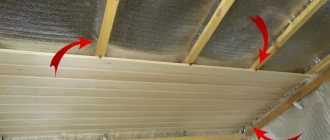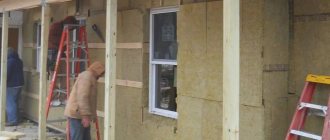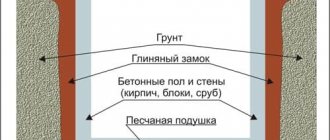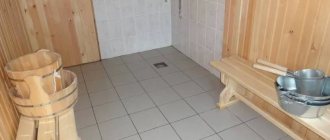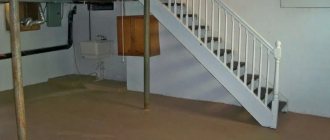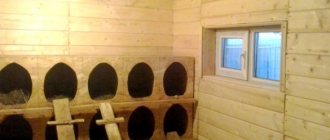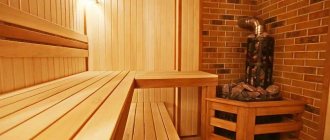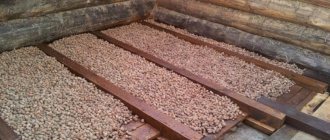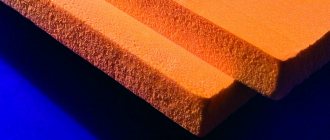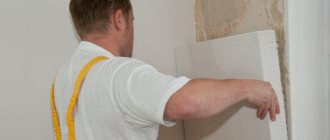SHARE ON SOCIAL NETWORKS
FacebookTwitterOkGoogle+PinterestVk
The operating conditions of the bathhouse differ from those that most buildings have to face. Therefore, the issue of high-quality vapor and heat insulation needs to be given special attention. Let's consider how to insulate the ceiling, floor, walls in a bathhouse and what technology to choose in order to create a suitable microclimate and reduce heat loss to a minimum, saving your own efforts and resources.
Insulating the ceiling in a bathhouse is one of the most important aspects of construction, allowing you to protect the building from the aggressive effects of temperature, steam and moisture
Why is it necessary to insulate the ceiling in a bathhouse: structural features
A bathhouse is a room that is periodically heated for the purpose of taking health procedures. A special microclimate is formed inside the room, characterized by high temperature and humidity. Of course, this cannot but have an impact on those building materials that have to be exposed to such influence.
Arranging a bathhouse requires special attention in terms of hydro-, steam- and thermal insulation
In addition, one has to take into account the costs associated with the use of this or that amount of fuel. If a building is prone to cooling quickly, large amounts of fuel will be required to maintain the appropriate temperature. And given the fact that, according to the laws of physics, warm air is lighter than cold air, it is the roof of the bathhouse that requires insulation, through which significant heat loss occurs.
But on the way to erecting a barrier to retain warm air indoors, there is one more aspect that all bathhouse owners should pay special attention to. High humidity becomes a source of large amounts of condensation, which, if the roof is not insulated correctly, can accumulate. This often causes the destruction of wooden elements of the structure.
Interesting fact ! High humidity is a favorable environment for the growth and development of various microorganisms: fungi, mold and bacteria. Ill-conceived vapor and heat insulation can cause them to appear and multiply.
Materials for insulation and insulation of the bathhouse are selected depending on the type and size of the building
The key function of good insulation
You don’t need to know physics well to understand: the higher the temperature in the bathhouse is required, the more difficult it is to build a barrier to maintain it.
There are three main leak patterns, which we suggest you familiarize yourself with right now:
- Heated air passes through the cracks at the top.
- Heat begins to move from heated objects to colder ones.
- Heat waves cross homogeneous barriers.
When laying good material, its main function is successfully implemented - to prevent any heat leakage. When the procedure is not performed well enough, condensation can be noticeably deposited on the ceiling; it takes much more time to warm up the room, and there are also more fuel resources.
Insulation of the ceiling in a bathhouse with a cold roof, depending on the characteristics of the roof
The roof of a bathhouse can be represented by one of two types: with an attic space and without it. In the first case, the air layer itself creates a fairly effective barrier, which has a positive effect on the building’s ability to retain heat. But this does not mean that the presence of an attic completely eliminates the need for insulation work.
If the bathhouse does not have an attic or attic, then high-quality thermal insulation is an almost mandatory condition for the further use of the building for its intended purpose.
Regardless of what type of room you are faced with, the first and extremely important step is to provide a vapor barrier layer. Available materials such as aluminum foil, high-density cardboard, which is pre-impregnated with drying oil, or wax paper are perfect for this.
Before laying the thermal insulation layer, you should take care of the reliable vapor barrier of the bathhouse roof
Helpful advice! If work is being done to insulate the ceiling in a bathhouse where there is an attic space, then it is recommended to coat the ceiling boards on the roof side with a layer of clay about 2-3 cm.
How to insulate a bathhouse ceiling: the best thermal insulation materials
During the heating process, the temperature and humidity in the room reaches extremely high levels. Therefore, special requirements are imposed on the building materials that are used in the process of arranging this room, namely, they must be resistant to such influences and not emit hazardous substances when heated.
In addition, it is not recommended that the weight of the insulation be too large. It is preferable to choose a lightweight material that is simple and convenient both in transportation and installation. And of course, we must not forget about such a characteristic as fire resistance, which is important for such a room as a bathhouse.
The modern market offers a wide variety of insulation and insulation materials for buildings, so it is quite easy to choose high-quality material based on their required characteristics and financial capabilities.
Do-it-yourself insulation of a bathhouse ceiling: advantages and disadvantages of mineral wool
Mineral wool is by far the most popular option among all. It is often used for insulation not only of bathhouses and garages, but also for residential buildings. In itself, it is a fibrous material that has excellent thermal insulation characteristics and can be presented in one of three types:
- glass wool;
- stone wool;
- slag wool.
But if the first option is familiar to almost everyone, then not everyone has seen the other two. Rock wool is a material made primarily from basalt, although it is sometimes made from other rock melts. Slag wool is very similar to cinder blocks, for the production of which blast furnace slag is used.
Mineral wool is characterized by significant resistance to high temperatures and also has excellent heat and sound insulation properties
In addition to the fact that mineral wool has low thermal conductivity, which allows it to be used for thermal insulation of ceilings and walls, it has another significant advantage. Unlike other materials, it cannot serve as a breeding ground for microorganisms: fungi, mold, small insects or rodents, which is very useful for summer cottages.
As for other characteristics, mineral wool is not prone to fire and does not react in any way to temperature changes: it does not deform or shrink. Light weight and convenient packaging (usually in the form of rolls or rectangular slabs) make it easy and convenient to work with the material, even alone.
Of course, this material also has disadvantages that one way or another will have to be taken into account:
- mineral wool can absorb moisture;
- it contains phenols, which can potentially pose a hazard to human health.
Insulation with mineral wool is necessarily accompanied by additional waterproofing of the surface
Both of these disadvantages can be neutralized during the installation process, providing the insulation with high-quality vapor and waterproofing, completely eliminating the risk of contact of mineral wool with air under the ceiling. This is especially true for warm and humid air, which is concentrated indoors.
Helpful advice! Despite the fact that, if all installation rules are followed, mineral wool does not pose a real threat to health, during its installation it is necessary to be careful and use protective equipment, since its small fibers can cause irritation to the skin and eyes.
Insulation of the ceiling in a bathhouse with expanded clay: features of use
Expanded clay is small-sized pebbles that consist of clay and have a porous structure. If we take into account all the factors, then expanded clay can be called the most suitable material for insulating the ceiling in a bathhouse. Of course, if the building has attic space and there is a possibility of using it.
Distinctive features of expanded clay as an insulation material are the high hydrophobicity of the material, as well as resistance to the development of microorganisms and fungi
The advantages of this choice can confidently include the following aspects:
- expanded clay is completely safe: it does not support combustion, is environmentally friendly and even in the event of a fire will not release hazardous substances into the atmosphere;
- over time, as well as under the influence of external factors, expanded clay does not deteriorate and does not decompose;
- the cost of the material is quite low;
- bacteria and fungi do not consider expanded clay an attractive environment for life.
In addition, expanded clay is superior to mineral wool in its ability to not absorb moisture. And although the need to equip steam and waterproofing layers remains, the risk of moisture accumulation inside the insulation layer is much less. It should also be noted that the service life of expanded clay is one of the longest when compared with other materials.
Expanded clay can be used to insulate both ceilings and floors
Is it worth it to insulate the ceiling from the inside with polystyrene foam?
At a certain period, foam plastic was the leader among thermal insulation materials, which were used to insulate not only bathhouses, but also residential buildings. But with the advent of alternative options, its significant shortcomings became noticeable. So, for example, in the event of a fire, polystyrene foam burns well, while also emitting toxic smoke that can harm human health.
In addition, polystyrene foam is not very resistant to external factors, collapsing under the influence of high temperatures, which is inevitable if it is used in a bathhouse.
For these reasons, we can conclude that polystyrene foam is far from the most suitable material for this purpose and it is better to give preference to another material that is more stable and suitable for its characteristics.
Many builders prefer to insulate the ceiling of bathhouses with penoplex foam with a thermal layer rather than polystyrene foam
Using ecowool as insulation for a bath
Another material that is popular among insulation materials and is often used for bathhouses and garages is ecowool. This fibrous material is made from cellulose, adding special impurities to it to provide protection against insects, bacteria and rodents. In addition, they make ecowool resistant to fire.
Related article:
Construction of a bathhouse in the country: video instructions and tips for creating a building
Video review of the technology for creating a bathhouse with your own hands, the main stages of building a building, requirements and tips. Common types of baths.
The advantages of this material include environmental friendliness, as well as low weight and the ability to fill even the smallest cracks and gaps, which is very convenient when it comes to working with a not too smooth surface. It does not emit any toxic substances so, like expanded clay, it is completely safe for human health.
But there is also a significant drawback: the effectiveness of using ecowool is directly related to the presence of ventilation, as well as a high-quality waterproofing layer, which is designed to remove moisture. This is due to the fact that ecowool itself is very prone to absorbing condensation, which negatively affects its thermal insulation characteristics.
Ecowool, as an environmentally friendly material, is used for insulation and insulation of walls, floors and ceilings
There are two ways to apply this heat insulator to walls, the so-called “dry” and “wet”. The main difference and at the same time complexity of the second option is the need to use special equipment for this, the rental of which will cause quite high prices for insulating the ceiling using this method.
Insulating a bathhouse inside using a mixture of cement and sawdust
This method can confidently be called the oldest among all those described, since these materials were used for insulation long before thermal insulation materials such as polystyrene foam and mineral wool appeared on the market.
Interesting fact! Typically, cement and sawdust are used to create a suitable mixture. Although the option of replacing these components with clay and straw is quite acceptable.
First of all, prepare a dry mixture, which includes sawdust, lime and cement in a ratio of 10/1/1, respectively. After mixing all the dry ingredients, add 1.5 parts of water, pouring it in gradually and mixing thoroughly so that the solution is homogeneous. After this, all that remains is to place the mixture on the surface and level it to an even layer.
You can insulate a bathhouse from the inside using inexpensive materials such as cement and sawdust, mixing them in the correct proportions
Experts recommend using sawdust to create such a mixture, which has previously been dried for several months, or better yet, a whole year.
If all recommendations and technologies are followed, you can ultimately obtain high-quality, environmentally friendly material. Although we have to admit that in terms of thermal insulation characteristics it is still inferior to mineral wool and even expanded clay. So, perhaps, its only advantage is its low cost, which, however, entails quite a lot of hassle.
Surface preparation
| Insulation | Volumetric mass, kg/m3 | Unit | -15 C | -20 C | -25 C | -30 C | -35 C | -40 C | -45 C | -50 C |
| Expanded polystyrene plates, polystyrene foam | 40….100 | mm | 40 | 40 | 50 | 60 | 60 | 70 | 70 | 80 |
| Mineral slabs | 200 | mm | 60 | 70 | 80 | 90 | 90 | 100 | 110 | 110 |
| Sawdust with lime | 300 | mm | 70 | 90 | 110 | 120 | 140 | 160 | 180 | 200 |
| Expanded clay gravel | 500 | mm | 90 | 120 | 140 | 160 | 180 | 200 | 220 | 240 |
| Granulated slag | 500 | mm | 140 | 160 | 190 | 210 | 240 | 260 | 280 | 300 |
| Fuel slag | 700 | mm | 170 | 200 | 230 | 260 | 280 | 310 | — | — |
| Pumice | 600 | mm | 170 | 200 | 230 | 240 | 260 | 280 | — | — |
How to properly insulate a roof ceiling? To protect the premises from the penetration of cold, all floor joints are checked for cracks before starting work. They should be filled with foam, gypsum or a mixture of lime and tow. Wooden structures are coated with antiseptic compounds and fire retardant mixtures. When replacing old insulation, you should inspect the beams, and if rotten boards are found, replace them with new ones.
It’s also worth checking the ventilation system – ridge and eaves vents. Unlike attics, a cold attic must be well ventilated. Otherwise, the beams and rafters will quickly rot as a result of condensation accumulation.
The thickness of the ceiling (see table) depends not only on the type of material and its thermal insulation properties, but also on the area of residence.
How to insulate a private house with your own hands: roof, walls and foundation, description of thermal insulation materials offered on the market (Photo & Video) + Reviews
Features of the arrangement of vapor barrier and waterproofing layers
The presence of a vapor barrier layer is not a whim, but a real necessity. Especially when it comes to rooms such as a bathhouse, where hot air is an integral part of using the room for its intended purpose. Rising in the form of steam, moisture can have a destructive effect on the insulation and contribute to the formation of mold and mildew on the wooden elements of the bathhouse frame.
Scheme of insulation and insulation of a bathhouse roof
In order to avoid problems that may arise as a result of moisture accumulation on the ceiling and walls, special films and coating materials are used, for example, anti-condensation membranes. When choosing a suitable material, it is advisable to purchase one that has a foil layer.
Helpful advice! During the installation of a vapor barrier film, it is very important to pay attention to its integrity. It is necessary to prevent the occurrence of gaps, as this will greatly affect the technical characteristics of the coating.
To ensure waterproofing, special films are used, which can be purchased at hardware stores. Sometimes the most ordinary polyethylene of sufficient density or cheap roofing felt is used.
To protect the bath frame from moisture, it is recommended to use a waterproofing membrane, which can be mounted in contact with the insulation without losing its properties
Advantages and disadvantages of mineral wool
- The material does not burn. It is a barrier to open fire. Based on this, insulating a bathhouse with mineral wool is an additional fire protection for building structures. The resistance of the material to high temperatures is amazing - more than 1000 degrees.
- Increased insulating properties. Proper organization of work with mineral wool guarantees the warmth of the surfaces of enclosing structures.
- Excellent sound insulation. This indicator is very important when insulating the ceiling and walls of a bathhouse. Not every material can “boast” of such a property.
- High frost resistance.
- No temperature deformations.
- Chemical and biological resistance.
- Easy to install. The light weight and sufficient thickness of the material allows it to conveniently fill any spaces in building structures, which speeds up their completion.
- Economical. The manufacturing process of mineral wool does not require significant expenses, so its cost is low.
- Solid insulation thickness, since it is taken into account when constructing wooden floors and frames.
- Moisture resistance. Not all types of mineral wool have this. Many insulation systems require waterproofing.
Do-it-yourself insulation of a floor ceiling: step-by-step instructions
A deck ceiling is an excellent option for buildings that are used seasonally and have a small area. But in such a design there is not a lot of space for bulk insulation. In addition, such a ceiling is also not able to withstand a lot of weight. Therefore, the choice of material should be approached more responsibly.
In order to have enough space for laying insulation, the floor ceiling should be placed slightly lower than the height of the walls. And after that, you can begin step-by-step work according to the following instructions:
- First of all, it is necessary to lay a vapor barrier layer on the attic side. In this case, the side on which the foil is located should be facing down. The material is laid with an overlap of approximately 10-15 cm, and to ensure tightness, you also need to tape the joints with tape.
- The selected thermal insulation material is laid on top. In this case, mineral wool or expanded clay is best suited, since the floor ceiling is not intended for heavy loads.
- A layer of waterproofing material is placed on top, which can be roofing felt or polyethylene film. Laying must be done with an overlap, and the seams must be carefully taped.
- The final layer should consist of sheets of plywood or boards, which will provide reliable protection for the previous layers.
The flat ceiling is easy to use, particularly in terms of insulation. If necessary, layers of insulators can be replaced without much effort
This is a simple method that is relevant if you do not plan to spend too much money and time on it. If the area of the bathhouse is large enough or it is necessary to use the space under the roof for storage, then this option will not be very suitable due to its fragility. In this case, it is better to give preference to a false ceiling.
How else can you insulate a steam room?
You can hem the ceiling with a 50 mm unedged board. Narrow boards are attached to it from the outside for support, which are fixed to the wood grouse. For further cladding, tongue-and-groove aspen boards are used. It is attached with some gaps to narrow support boards.
In the attic, a vapor barrier membrane is first laid, on top of which sawdust mixed with clay is poured in a layer of 3 cm. Next, a 15 cm layer of basalt wool, density 125, is laid, and then a polyethylene film for protection from the wind. After this, the entire surface is covered with subfloor boards.
For bathhouses with log floors, a slightly different approach is used. To line the ceiling, a special sheathing is placed on the inside of the bathhouse. From the attic side, glassine is first laid and 20 cm of sand is poured. The owners add additional layers at their own discretion.
A detailed study of the insulation features of the steam room and other rooms in the bathhouse will help the owners of such structures to do everything right. Then a bathhouse built with your own hands will delight you with warmth, comfort and good steam. The options we have described can be modified and added at your discretion. We hope everything works out for the best for you.
Do-it-yourself insulation of a false ceiling: step-by-step instructions
The design of a suspended ceiling involves attaching to the upper part of the wall not the flooring itself, but support beams, for which a wooden beam or several boards spliced together are most often used. A ceiling is attached to the beams above and below, which also serves as the floor of the attic. Well, in the middle between the top and bottom layers a layer of thermal insulation material is laid, as well as hydro- and vapor barriers.
The installation process may differ slightly depending on which insulation was chosen, however, in general, the technology remains the same. If mineral wool is used for this purpose, the procedure is as follows:
- The first layer of waterproofing material is laid, which is attached to the upper surface of the beams using a furniture stapler. As in all other cases, the overlaps must be at least 10 cm, and the joints must be additionally glued;
Scheme of arrangement and insulation of a false ceiling
- boards or plywood are laid on top of the waterproofing, thus ensuring strength and reliability of the structure;
- mineral wool of suitable thickness is placed in the spaces between the beams based on the following standards: 150-180 mm for regions with a temperate climate, 200-250 mm for regions characterized by severe frosts. As with waterproofing material, the connection of two separate parts of the material must be overlapped;
- The vapor barrier film is attached to the floor beams from the bottom side. It is highly recommended that its edges be attached to the top of the walls. Since this is a very delicate material, it is important to work with it carefully, avoiding damage and tearing;
- perpendicular to the beams, wooden slats are attached on top of the vapor barrier material;
- The final stage is attaching the lining using self-tapping screws or nails to these slats.
This insulated ceiling is very durable and can withstand heavy loads, so the attic space can be used to create an attic or as storage for various accessories.
The final layer of bathhouse ceiling insulation is the installation of a vapor barrier film, which must be handled quite carefully
Methods
From the inside
To insulate the bathhouse from the inside, environmentally friendly, safe materials are chosen.
- Mineral wool is laid between the installed lathing beams.
- Foil on a thick paper base is attached on top with paper clips to a wooden strip with an overlap on the wall, which will reflect the rays of heat and retain it in the room.
- The joints are taped with adhesive foil tape.
- Planks measuring 2x5 cm are nailed to the beams for a frame under the lining (how to easily and quickly cover a ceiling with lining?).
Outside
Use
- Mineral wool. The most common type of insulation, which requires laying a waterproofing layer.
- Polystyrene foam is usually used for baths made of brick or concrete.
- Expanded clay.
Floor type thermal insulation
- Thermal insulation material is laid directly on the laid, knocked down ceiling boards. Usually mineral wool is chosen as insulation. The thickness is determined according to the individual characteristics of the bath.
- Then they begin laying a vapor barrier to protect against condensation and steam of the new thermal insulation layer.
- The top layer is covered with roofing felt or plastic film. The method is suitable for baths without an attic.
Hemmed
How to hem or hang ceiling layers:
- Installation is possible in bathhouses with an attic space if there are ceiling beams that act as a supporting frame. All components of the suspended ceiling are attached to it.
- The lower part of the beams is sewn up with a vapor barrier using a stapler or additional strips.
- The overlapping sheets of material are glued with mounting tape at the joints. A film allowance of 15–20 cm wide is left along the perimeter of the film on the walls.
- Then the vapor barrier layer is covered with eurolining or edged boards.
- A layer of thermal insulation material is laid on the vapor barrier between the beams, followed by a waterproofing film.
- The last stage - the surface is covered with edged or unedged boards over the beams, forming the floor of the attic.
Panel
It is assembled from panels of the same size, forming an insulated solid ceiling.
- From two beams and boards 60 cm long, panels are knocked together so that 5 cm remains from the edge of the board to the edge of the slats. Such “visors” create gaps between the panels during installation. They are filled with heat insulator.
- The finished panels with thermal and waterproofing installed in them are nailed with boards to the cross beams of the floor. In this case, the first board - solid - supports all the ceiling panels, the next one can consist of parts, then solid again, etc.
- The inside surface should be sheathed with decorative materials, such as the walls of the room
Do-it-yourself insulation of the ceiling of a bathhouse without an attic: nuances of work
The technology for insulating a wooden or panel bath, in the case of a complete absence of an attic space, has some differences from those discussed earlier. In this case, it is necessary to secure the vapor barrier material, and then attach the insulation itself. The beam beam and the final layer - ceiling boards - are already attached to it.
Particular attention should be paid to the junction of the insulation and the pipe. First of all, this is necessary to ensure compliance with fire safety standards. The indentation provided for by the rules must be at least 200 mm. Naturally, you can’t just leave a hole, and therefore a simple box consisting of rafter legs is mounted. Its main role is the separation of insulation and pipes.
Helpful advice! The inside of the box can also be filled with thermal insulation material. True, it must be fire-resistant and not susceptible to high temperatures. For example, stone wool is suitable for this.
Before laying layers of insulation and insulation, it is recommended to treat the wooden ceiling with special means to eliminate the possibility of the development of harmful bacteria and fungi
Another important task that faces the owner who is insulating the ceiling of a bathhouse without an attic is to completely eliminate the risk of condensation. Therefore, all vapor and waterproofing materials must be of high quality and attached in strict accordance with the rules and regulations.
We carry out preparatory work
Regardless of which thermal insulation material you choose for your bathhouse, you should carry out preparatory vapor barrier work before directly laying it.
Why do you need a vapor barrier? It will block the entry and deposition of wet vapors on the thermal insulation. Why is it important? Because if moisture accumulates on the insulation, this will immediately lead to several negative consequences: firstly, the weight of the ceiling structure will increase; secondly, the insulating qualities of the insulation will decrease; thirdly, the service life of thermal insulation will be significantly reduced.
If your bathhouse does not have an attic, use heat-reflecting plastic film or aluminum foil as a vapor barrier. The first material must have lint - it is they that will trap condensation. It is more rational and economical to use foil in those rooms where it is important to maintain a high temperature, for example in a steam room and shower, and film in other, less demanding rooms. Use a staple gun to attach the vapor barrier to the ceiling. Even if you overlap the material, carefully cover the joints with self-adhesive tape to ensure the necessary tightness.
In steam rooms with an attic, you can use the same materials, but the roof on the inside must first be treated with clay. The minimum application layer is 2 cm.
Insulation of a bathhouse outside and inside: features of wall insulation
The first thing you should pay attention to when planning work on insulating the walls of a bathhouse is whether you want to place a thermal insulation layer on the inside or outside. Both options are acceptable, however, the first is used extremely rarely for a number of reasons:
- Insulating the inside of garages, bathhouses and modest-sized houses is an irrational use of the small space that is available. Obviously, laying all the necessary layers will make the room smaller, which in some cases is not ergonomic;
- the humidity in the bathhouse can be so high that even if all the necessary conditions are met and the vapor and heat insulation layers are installed, it is almost impossible to guarantee that the heat insulator will not be exposed to moisture sooner or later;
- Insulating the walls in a bathhouse from the inside with your own hands allows you to retain heat inside the room, but is not able to protect the walls from freezing from the outside. This temperature difference often has a negative impact on the condition of the building.
Depending on the size and type of structure of the bathhouse, insulation and insulation can be carried out both from the inside and from the outside, or from both sides
Let's consider the features of wall insulation depending on the material that was used to construct the building.
Features of insulation in a wooden bath: log steam room
At first glance, it may seem that log buildings do not particularly require thermal insulation, since the wall looks quite airtight, and the wood does a good job of retaining heat. But in fact, the problem lies in the fact that the timber is highly susceptible to shrinkage and cracks form over time. They become the main sources of cold.
The most effective way to seal the resulting gaps is to lay insulation between the logs during the construction stage. Then, using a hammer and caulk, all remaining cracks, even the smallest ones, are clogged and treated with sealant.
Interesting fact! To this day, fans of environmentally friendly materials continue to use plants such as moss or cuckoo flax to fill cracks in walls.
Thermal insulation of a bathhouse made of timber occurs at the construction stage, when inter-crown insulation is laid between the logs
Do-it-yourself insulation of a bathhouse from the inside: brick, block and frame buildings
Perhaps one of the most labor-intensive processes is insulating the inside of a bathhouse from expanded clay concrete blocks, bricks or other materials to which it is not so easy to attach, and you also have to carefully select the material, taking into account its weight and size.
For example, if we are talking about insulating a frame structure that is not capable of withstanding heavy loads, it is simply impossible to do without careful preliminary calculations. As an expensive, but ideal option for this purpose, you can consider spraying polyurethane foam. This method can be used both for insulating a bathhouse made of foam blocks from the inside, and for buildings made of almost any material.
In some cases, extruded polystyrene foam boards are used. For internal insulation this is not a very suitable option, as it takes up a significant amount of space, but for external cladding there is no better solution.
In the case of a small bath area, to save space, you can consider the option of spraying polyurethane foam as insulation for the building
Helpful advice! Insulation by spraying polyurethane foam must be carried out by professionals and in compliance with all technological requirements and standards. Also, high-quality specialized equipment is required.
Vapor barrier
Is it possible to do without a vapor barrier in a bathhouse? Of course not, if the tree is pathetic. If you don’t tend to spend money on wind and rot and your bathhouse is expensive, insulation of the ceiling, vapor barrier is something you can’t do without. Another thing is that there is a lot of debate about whether to use foil as a vapor barrier. But this is already a matter of faith. In fact, those who cope with similar work themselves can find their own answer - by steaming with and without foil. By the way, its advantages include high heat resistance, which means that if you install something else for vapor protection, then it will be with a temperature range corresponding to a specific bathhouse - Russian or Finnish.
Find out more about foil and foil insulation.
